Related Research Articles

The 2nd Cavalry Regiment, also known as the 2nd Dragoons, is an active Stryker infantry and cavalry regiment of the United States Army. The Second Cavalry Regiment is a unit of the United States Army Europe and Africa, with its garrison at the Rose Barracks in Vilseck, Germany. It can trace its lineage back to the early part of the 19th century.
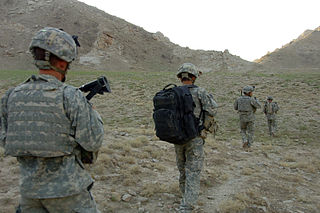
Long-range surveillance (LRS) teams were elite, specially-trained surveillance units of the United States Army employed for clandestine operation by Military Intelligence for gathering direct human intelligence information deep within enemy territory. Classic LRS employment is to infiltrate deep into enemy territory, construct hide and surveillance sites, and provide continuous surveillance/special reconnaissance of an intelligence target of key interest.

The United States Cavalry, or U.S. Cavalry, was the designation of the mounted force of the United States Army. The United States Cavalry was formally created by an act of Congress on 3 August 1861 and ceased as a distinct Army branch in 1942. The name "cavalry" continues to be used as a designation for various specific United States Army formations and functions.

The brigade combat team (BCT) is the basic deployable unit of maneuver in the U.S. Army. A brigade combat team consists of one combat arms branch maneuver brigade, and its assigned support and fire units. A brigade is normally commanded by a colonel (O-6) although in some cases a brigadier general (O-7) may assume command. A brigade combat team contains combat support and combat service support units necessary to sustain its operations. BCTs contain organic artillery training and support, received from the parent division artillery (DIVARTY). There are three types of brigade combat teams: infantry, Stryker, and armored.

The 9th Cavalry Regiment is a parent cavalry regiment of the United States Army. Historically, it was one of the Army's four segregated African-American regiments and was part of what was known as the Buffalo Soldiers. The regiment saw combat during the Indian and Spanish–American Wars. During Westward Expansion, the regiment provided escort for the early western settlers and maintained peace on the American frontier.
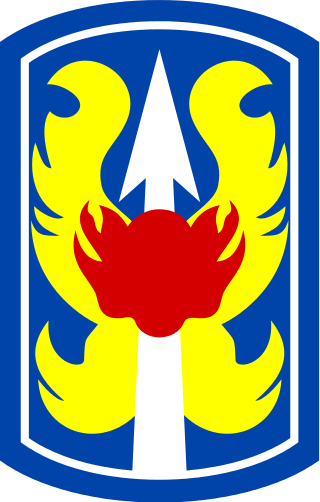
The 199th Infantry Brigade (Light) is a unit of the United States Army which served in the Army Reserve from 1921 to 1940, in the active army from 1966 to 1970 (serving in the Vietnam War), briefly in 1991–1992 at Fort Lewis, and from 2007 as an active army training formation at Fort Moore.
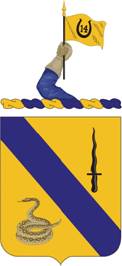
The 14th Cavalry Regiment is a cavalry regiment of the United States Army. It has two squadrons that provide reconnaissance, surveillance, and target acquisition for Stryker brigade combat teams. Constituted in 1901, it has served in conflicts from the Philippine–American War to the Operation Iraqi Freedom and Operation Enduring Freedom in Afghanistan.

Cavalry Scout is the job title of someone who has achieved the military occupational specialty of 19D Armored Reconnaissance Specialist in the Combat Arms branch of the United States Army. As with all enlisted soldiers in the United States Cavalry, the person holding the Scout specialization will still be referred to as a "Trooper", the traditional colloquialism denoted in the cavalry's Order of the Spur.

The M1127 Reconnaissance Vehicle (RV) is a wheeled armored personnel carrier in the Stryker family, developed and produced by General Dynamics Land Systems Canada (GDLS-C) and is currently in service with the US Army.

The 3rd Brigade Combat Team, 1st Cavalry Division is a combined arms armored brigade of the 1st Cavalry Division based in Fort Cavazos, TX. Major equipment includes the M1A2SEP Tanks, M2A3 & M3A3 Bradley infantry fighting vehicles, M109A7 Paladin howitzers, and M1114 up-armored Humvees.
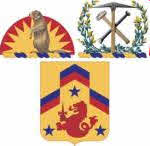
The 82nd Cavalry Regiment is a parent regiment in the United States Army National Guard. It is represented in the Oregon Army National Guard by the 1st Squadron, 82nd Cavalry, part of the 81st Stryker Brigade Combat Team.

The 1st Squadron, 75th Cavalry Regiment is a United States Army cavalry squadron established in 2004. It is the Reconnaissance, Surveillance and Target Acquisition Squadron (RSTA) squadron of the 2nd Brigade Combat Team "Strike" ♥, 101st Airborne Division. It performs reconnaissance and cavalry missions in support of that brigade.

In the United States (US) military, a beret flash is a shield-shaped embroidered cloth that is typically 2.25 in (5.72 cm) tall and 1.875 in (4.76 cm) wide with a semi–circular base that is attached to a stiffener backing of a military beret. These flashes—a British English word for a colorful cloth patch attached to military headgear—are worn over the left eye with the excess cloth of the beret shaped, folded, and pulled over the right ear giving it a distinctive appearance.
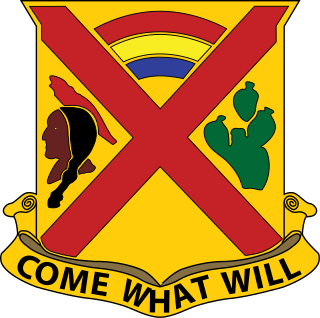
The 1st Squadron, 108th Cavalry Regiment is a Reconnaissance, Surveillance, and Target Acquisition squadron of the 48th Infantry Brigade Combat Team, Georgia Army National Guard. 1st Squadron provides the 48th IBCT both mounted and dismounted reconnaissance capabilities. Prior to 2007, the unit was designated as the 1st Battalion, 108th Armor Regiment.

Armoured reconnaissance is the combination of terrestrial reconnaissance with armoured warfare by soldiers using tanks and wheeled or tracked armoured reconnaissance vehicles. While the mission of reconnaissance is to gather intelligence about the enemy with the use of reconnaissance vehicles, armoured reconnaissance adds the ability to fight for information, and to have an effect on and to shape the enemy through the performance of traditional armoured tasks.

M1134 Anti-Tank Guided Missile Vehicle is a U.S. anti-tank missile carrier that is an armored fighting vehicle from the Stryker family of vehicles. As the primary tank destroyer system of the US Army's Stryker Brigade Combat Team (SBCT), the M1134 ATGM Vehicle reinforces the SBCT's infantry battalions, reinforces the SBCT reconnaissance squadron and provides long-range direct fire. Models with the double V-hull upgrade are known as the M1253 ATVV.

The 151st Cavalry Regiment was a United States Army cavalry regiment represented in the Arkansas Army National Guard by 1st Squadron, 151st Cavalry Regiment, headquartered in Warren, Arkansas, an element of the 39th Infantry Brigade Combat Team.
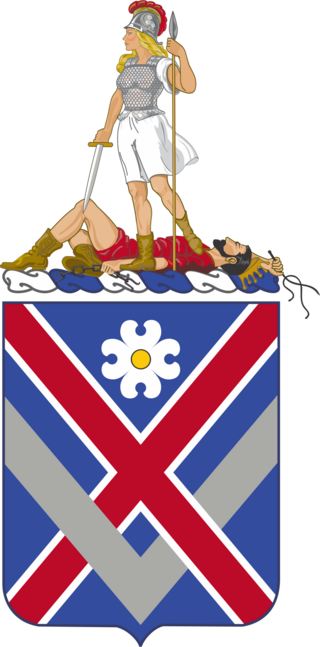
The 183rd Cavalry Regiment is a cavalry regiment of the United States Army, represented in the Virginia Army National Guard by 2nd Squadron, 183rd Cavalry (2-183). The squadron is the reconnaissance, surveillance, and target acquisition squadron of the 116th Infantry Brigade Combat Team, part of the 29th Infantry Division.
References
- 1 2 3 4 5 6 7 8 Williams, CPT Graham; Baumgartner, 1SG Brian. "The Dismounted Recon Troop: A Relevant Force For The IBCT" (PDF). Moore.Army.Mil.
{{cite web}}: CS1 maint: numeric names: authors list (link) - 1 2 3 4 5 6 7 Headquarters, Department of the Army (November 2010). "ATTP 3-20.97 Dismounted Reconnaissance Troop" (PDF). Global Security.
- ↑ "Long Range Reconnaissance veterans make Fort Benning their home". www.army.mil. 13 September 2016. Retrieved 14 May 2024.
The legacy of LRRP units also continues on in the US Army's Long Range Surveillance and Reconnaissance, Surveillance, and Target Acquisition (RSTA) squadrons.
- ↑ "Operation ENDURING FREEDOM RECONDO School | Small Wars Journal". smallwarsjournal.com. Retrieved 14 May 2024.
- 1 2 3 4 5 6 7 "JP 3–55 Doctrine for Reconnaissance, Surveillance and Target Acquisition Support for Joint Operations ( Full PDF)" (PDF).
- 1 2 FM 3–20.96 Reconnaissance and Cavalry Squadron. Department of the Army. May 2016. Ch. 1 Sec. 1
- 1 2 3 4 5 6 7 8 9 10 11 12 13 14 FM 3–20.96 Reconnaissance and Cavalry Squadron. Department of the Army. May 2016. Ch. 1 Sec. 3
- 1 2 3 The U.S. Military’s Force Structure: A Primer. Congressional Budget Office. June 2016. Chapter 2 - Army Armored Brigade Combat Teams
- 1 2 3 The U.S. Military’s Force Structure: A Primer. Congressional Budget Office. June 2016. Chapter 2 - Army Infantry Brigade Combat Teams
- 1 2 3 Hovatter, CPT Ryan P. (March 2017). "AT for a Dismounted Recon troop" (PDF). Infantry Magazine, moore.army.mil. p. 15. Retrieved 7 May 2024.
{{cite news}}: CS1 maint: url-status (link) - 1 2 Staff, News (1 May 2024). "2nd Brigade Combat Team's Multi Functional Reconnaissance Company takes part in Operation Lethal Eagle". Clarksville Online - Clarksville News, Sports, Events and Information. Retrieved 8 May 2024.
{{cite web}}:|first=has generic name (help) - ↑ "Screaming Eagles Lead the Way in Continuous Transformation". DVIDS. Retrieved 8 May 2024.
- 1 2 INSIDE the 'Hunter Killer Platoon' of the 101st Airborne Division . Retrieved 8 May 2024– via www.youtube.com.
- 1 2 The U.S. Military’s Force Structure: A Primer. Congressional Budget Office. June 2016. Chapter 2 - Army Stryker Brigade Combat Teams
- ↑ "Fort Moore | Reconnaissance And Surveillance Leaders Course 2E-F173/011-ASI6B". www.moore.army.mil. Retrieved 7 May 2024.
- ↑ Castoro, Dan; Frye, Joe (1 January 2011). "RSLC: course trains scouts for Infantry RSTA formations". Infantry Magazine. U.S. Army Infantry School.
- ↑ "Fort Moore | Cavalry Leader's Course". www.moore.army.mil. Retrieved 7 May 2024.
- ↑ John Pike. "1st Battalion - 263rd Armor Regiment". Globalsecurity.org. Archived from the original on 18 September 2015. Retrieved 11 November 2015.
- ↑ Search "MARS MEN". "Special Designations". US Army Center of Military History.
- ↑ "Into the Sunset". The Dispatch: Official Magazine of the Texas Military Department. August 2017. p. 10.